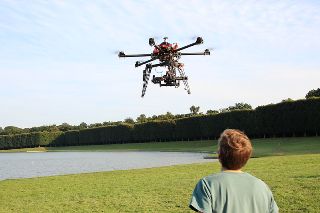May 30 2015
Male moths locate females by navigating along the latter’s pheromone (odor) plume, often flying hundreds of meters to do so. Two strategies are involved to accomplish this: males must find the outer envelope of the pheromone plume, and then head upwind.
 UC Riverside-led research shows that insect mating behavior has a lesson or two for drones. Photo credit: Lionel Allorge.
UC Riverside-led research shows that insect mating behavior has a lesson or two for drones. Photo credit: Lionel Allorge.
Can understanding such insect behavior be useful for robotics research? Yes, according to two entomologists whose research using computer simulations shows that such insect behavior has implications for airborne robots (drones) that ply the sky searching for signature odors.
The entomologists modeled plumes’ dispersal and insects’ flight strategies. Their model was based in part on the observed behavior of the gypsy moth in forests and in experiments in wind tunnels. The use of computer simulations allowed testing of many conditions that could not be observed directly in the field.
The simulations suggest that optimal strategies for robotic vehicles – airborne or ground-based – programmed to contact an odor plume need not involve the detection of wind flow in setting a foraging path.
“Our simulations shows that random walks – heading randomly with respect to wind and changing direction periodically – create the most efficient paths for the initial discovery of the plume and consequently the likelihood of the moth locating its source,” said Ring Cardé, a distinguished professor of entomology at the University of California, Riverside, whose lab led the research. “Such strategies are most apt to result in contact with plumes. This conclusion matches our previous field observations of moth searching flights and also suggests that previous theoretical studies suggesting specific headings with respect to wind flow, such as a crosswind bias, are not optimal as had been predicted. Our simulations show that paths aimed downwind are least successful.”
Cardé explained that in the model once the odor plume is encountered, the virtual moth navigates a course upwind to the odor’s source.
“This process is well understood in flying insects such as moths, flies and mosquitoes,” he said. “But first the plume must be found and the best rules for an efficient searching strategy – find it quickly with a minimal energy expenditure – had not been established.”
One application of the work may be in using airborne drones to find sources of odors from pollutants. Such drones could mimic natural orientation paths of insects searching for odors.
Study results appear online in Integrative and Comparative Biology.
The researchers simulated batches of 100 virtual moths that search simultaneously and independently for an odor plume in a boundless area that replicates natural wind conditions. The model creates a meandering wind direction and the wispy structure of natural odor plumes.
The research was supported by the Office of Naval Research. Cardé, who is the A. M. Boyce Chair in the Department of Entomology, was joined in the research by Josep Bau at the University of Vic—Central University of Catalonia, Spain. Bau was a postdoctoral researcher in Cardé’s lab.
The plume component in the simulations used by Cardé and Bau relies on a model developed by Jay Farrell, a professor of electrical and computer engineering at UCR.